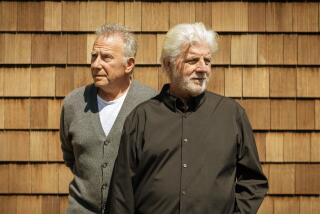Limerick’s Rise From ‘Ashes’
LIMERICK, Ireland — Limerick’s Windmill Street is a postman’s nightmare. Its small two-story stucco row houses are numbered 25, 2, 41, 1, 42 . . . there are three No. 1’s alone. But the house I’m looking for doesn’t seem to have a number at all. Painted pale yellow with a green door, its only distinctive feature is a stuffed Garfield the Cat stuck in the upstairs window.
It’s an ordinary house in an ordinary city, so unexceptional that no one would give it a second glance. Yet millions of people know it intimately because it’s one of the places Frank McCourt, author of the best-selling memoir “Angela’s Ashes,” lived when he was growing up poor and desperate in the slums of Limerick, Ireland, during the 1930s and ‘40s. This is what it was like on the McCourts’ first night in this house:
Dad and Mam lay at the head of the bed, Malachy and I at the bottom, the twins wherever they could find comfort . . . Then Eugene sat up, screaming, tearing at himself . . . when Dad leaped from the bed and turned on the gaslight we saw the fleas, leaping, jumping, fastened to our flesh. We slapped at them and slapped but they hopped from body to body, hopping, biting. We tore at the bites till they bled. We jumped from the bed, the twins crying, Mam moaning, Oh, Jesus, will we have no rest!
It’s hard to reconcile the misery depicted in McCourt’s book with Garfield in the window. In a way, the stuffed cat says it all. The terrible days in Limerick that McCourt wrote about so eloquently are gone, and good riddance to them. Yet it’s a measure of how moving his book is--and how much things have changed in Ireland--that people are coming back to see how it was.
Frank McCourt, with his evocative, funny-sad memoir, has done the unimaginable: He’s turned Ireland’s fourth-largest city into a hot destination. Limerick is a working city--computers, manufacturing--without the slick trappings of tourism. Which is precisely why it’s worth visiting. It hasn’t been Disneyfied.
“Angela’s Ashes,” widely praised for luminous prose, has sold close to 2 million copies in little over a year. It has won the Pulitzer Prize and the National Book Critics Circle Award, and was voted Book of the Year for 1997 by the American Booksellers Assn.
The book is not for the squeamish. As McCourt says, it’s a wonder he survived to tell the tale. He was born in New York of immigrant parents who moved the family back to Ireland when he was 4. Big mistake. They had lost one child in New York, and two more would die in Limerick. The father drank away his wages (when he worked at all), the mother begged for charity, and the children mostly fended for themselves. A number of villains emerge: members of the Catholic clergy, sadistic schoolmasters, callous social workers and--not the least--”the gray city of Limerick and the river that kills.”
It sounds horrible, depressing, nothing you’d willingly read about--much less visit. But people are. “Throngs of them,” sighs the bartender at the venerable W.J. South pub, newly famous as the favorite watering hole of Frank McCourt’s father.
“Oh yes, indeed, it’s been quite popular,” says Breda Bourke, supervisor of the Limerick tourist information office. “It started off with Americans, and now we’re getting a lot of inquiries from the Germans and the Japanese.”
*
Liam O’Hanlon, chairman of the Limerick Tourist Trade Assn., has led walking tours for years. Until recently, his routine was King John’s Castle, St. Mary’s Cathedral and other highlights of medieval Limerick. “It was the historical things that people were interested in,” he says. “Now, suddenly they’re walking in with ‘Angela’s Ashes.’ They expect to see what Frank McCourt has written about--but what he’s written about no longer exists.”
In fact, quite a few sites from the book remain, including the Leamy National School, the People’s Park, a slew of exquisite old churches and the St. Vincent de Paul Society townhouse where his mother, Angela, queued up for charity. But the slums McCourt described so unflinchingly are gone, cleared away during the 1950s and ‘60s.
The Irish economy is booming, thanks in part to the recent influx of European Union funds, and Limerick is no exception. Construction is everywhere--hotels, apartment blocks, pubs, restaurants. Blocks of once-elegant, 19th century Georgian row houses are being lovingly restored. On a bright fall weekend, the downtown streets are jammed, the shops and restaurants packed.
Down by Arthur’s Quay on the banks of the Shannon, there are posh stores, antiques shops and a gleaming new tourist information center. The prestigious Hunt Museum, with an impressive collection of antiquities, recently moved here from the city’s outskirts. Lovely old churches abound, and they’re not locked.
You can buy a boombox, a bottle of fine wine or a hand-knit sweater to die for. In Quinnsworth’s supermarket, I wandered aisles stocked with 12 kinds of marmalade and more brands of chocolate than I knew existed.
Truth to tell, I was pleasantly surprised by Irish food in general. Of course, a “full Irish breakfast” can be an alarming sight first thing in the morning, with lots of fried everything. But many places serve fresh ingredients, and the seafood, especially, is delicious. One night, I feasted on fillet of sea bream with crispy leeks and a smoked salmon butter sauce at a cool neighborhood restaurant called the Green Onion. Not all my meals in Limerick were as memorable, but it’s safe to say that Irish dining has successfully made it into the ‘90s.
*
It wasn’t just the food and the shops that drew me back to Arthur’s Quay again and again. It was the history. Limerick is oozing with it.
You can be walking down the street and look up to find yourself passing a 13th century castle. England’s King John ordered this fortress built in 1212 to guard the entrance to the city. Today, you can climb the tower’s steep stone staircase, peer through the narrow slitted windows and imagine yourself shooting arrows at the passersby below. When you finally reach the top, you can stride across the battlements for commanding views of the city and scan the approaching traffic on the Thomond Bridge.
From the castle, it’s a short walk to St. Mary’s Cathedral, Limerick’s oldest surviving building. Built in 1172, it’s famous for its 15th century choir stalls, made of dark oak with fanciful carvings. Outside, there are towering old trees, a wonderful atmospheric cemetery with crumbling Irish crosses.
As a backdrop to all this, the River Shannon is a constant--and increasingly lovely--presence. For years the city turned its back on the river and has only recently rediscovered it. Now there are waterfront parks and benches and monuments, and rowing sculls and boathouses. It’s a delightful scene on a quiet Sunday morning, with people riding by on bicycles and strolling couples.
Just a few blocks away from the former McCourt house, on Hartstonge Street, is a somewhat forbidding, Gothic-looking red-brick building with a crenulated roof. This was Leamy’s National School, home to cruel and/or demented schoolmasters and legions of barefoot, underfed students.
The school houses offices now--a tailor shop, a brass plaque company. Inside, it’s carpeted and renovated. A man with a tape measure around his neck comes out of the tailor’s, sees us and rolls his eyes. Have there been a lot of “Angela’s Ashes” pilgrims? “There have.” Has he read the book? “I haven’t.” (Nobody in Ireland says “yes” or “no.”) “A lot of people in Limerick are a bit sour over it,” he explains, adding, “The book’s got it all wrong. ‘Twasn’t like that. Not atall.”
Next door is the four-story, red-brick townhouse of the St. Vincent de Paul Society, where Frank’s mother, Angela, lined up for charity.
The society is still a source of clothing and furniture for Limerick’s poor, but “it’s much more user-friendly today,” O’Hanlon says. “You don’t find people queuing up outside anymore.”
Onward, to the People’s Park, where Frank took his small brothers to distract them from hunger. Even on a rainy day it’s inviting, with well-tended rose gardens, a fanciful Victorian drinking fountain and the greenest grass I’ve ever seen.
Down Barrington Street, past doctors’ and solicitors’ offices with lovely painted doors--Limerick has great doors--is Barrack Hill, site of another McCourt residence.
Roden Lane, where the McCourts shared a single lavatory with the rest of the block, is gone, but St. Joseph’s Church, where the young Frank received his first Communion and confirmation, is a looming presence. That’s where Frank applied to be an altar boy, and there, visible through the white wrought-iron fence, is the door that was slammed in his face.
Perhaps Frank found more comfort in the massive century-old Redemptorist Church on South Circular Road, a dark and beautiful refuge, with flickering votive candles, an intricate mosaic-tiled floor and eye-popping, elaborately gilded alcoves. Farther north, on Henry Street, is the huge Franciscan Church where Frank prayed to his patron saint, Francis of Assisi. Inside, it has the lovely smell of incense and candle wax. Old women click their rosary beads as shoppers pop in, genuflect and say a quick prayer.
On a rainy fall afternoon, waves of mist roll in from the River Shannon, down the Dock Road and through the streets and lanes. It’s a perfect day for a pint in South pub.
South’s seems ageless with its ancient mahogany wood, marble bar, etched-glass partitions and cozy alcoves called “snugs,” but, “Och, ‘tis changed,” says a guy nursing a Guinness. In McCourt’s day, he says, it was a third of the size. “There were terrible characters from the docks before. It’s all different now.”
But it doesn’t take long to find someone who grew up with McCourt.
“The lanes were full of rats,” Jerry, a South regular, is saying. “Full of rats they were. We’d wait for the full moon to come out . . . and a gang of us would go out. I’d kill about 80 on a good night--hit ‘em with a stick. That was our entertainment.”
George, on the next stool, went to school with Frank’s brother Malachy--they had the same master, “Hoppy” O’Halloran. “You’d be frightened for your life,” he said. “He’d run after you with a big stick. He’d bring you up and give you six slaps. Really hard, now. . . .”
Times were tough, they say, but happy. “You could leave your door open,” Jerry says. “There were very good people in the lanes--very neighborly. Everyone looked after one another. They were grand people. You could always get food from someone. “
“I didn’t like what Frank said about where we were living,” George says. “It’s not true. We weren’t that badly off. I wish him luck, but I don’t agree with the stuff he put in that book. But he’s got his money now.”
“Frank’s a decent enough fellow,” Jerry says. “I don’t begrudge him his success. He survived, and that’s it in a nutshell, isn’t it?”
‘Tis.
(BEGIN TEXT OF INFOBOX / INFOGRAPHIC)
GUIDEBOOK
On a Lark in Limerick
Getting there: Delta flies LAX-Shannon, connecting service only, one change of planes. Or fly LAX-JFK on a domestic carrier such as United or American; pick up Aer Lingus nonstop JFK-Shannon. Fares begin at about $890 including taxes. Limerick is 15 miles east of Shannon International Airport.
Where to stay: Limerick has a variety of hotels and B&Bs.; Jurys Hotel (Ennis Road, Limerick, telephone 011-353-61-327777), just across Sarsfield Bridge from the historic district, has restaurants, indoor pool, gym and tennis court. Rooms start at about $174 double.
Its downtown counterpart, Jurys Inn (Lower Mallow Street, tel. 011-353-61-207000), is less luxurious, but ideally located for “Angela’s Ashes” pilgrims, just blocks from Windmill Street, South’s pub and other sites. Rooms start at $75 double.
Or check out nearby Adare Manor (Adare, County Limerick, tel. 011-353-61-396566), with antique-filled rooms, riding stables, fishing and 18-hole golf course. Special winter weekend rates: about $200 per person double for two nights’ bed and breakfast, plus one evening meal.
Where to eat: The Green Onion (3 Ellen St.) near Arthur’s Quay serves up modern Irish cuisine in a funky, arty atmosphere. Dinner runs about $40 for two. Other restaurants worth a visit are Freddy’s (Theatre Lane, off Lower Glentworth Street) and Quenelle’s (Lower Mallow and Henry streets), known for innovative dishes. Bewley’s Restaurant on Cruises Street is good for a quick breakfast or lunch, with sumptuous baked goods. If you drive into nearby County Clare, try the delicious seafood and brown bread at Monk’s restaurant in the fishing village of Ballyvaughan.
“Angela’s Ashes” sites: Walking tours of “Ashes” sites are available through the Limerick tourist office (see below).
For more information: Irish Tourist Board, 345 Park Ave., 17th Floor, New York, NY 10154; tel. (800) 223-6470 or (212) 418-0800, fax (212) 371-9052.
Limerick Tourist Information Center, Arthur’s Quay, Limerick, Ireland; tel. 011-353-61-317522.
More to Read
Sign up for our Book Club newsletter
Get the latest news, events and more from the Los Angeles Times Book Club, and help us get L.A. reading and talking.
You may occasionally receive promotional content from the Los Angeles Times.







